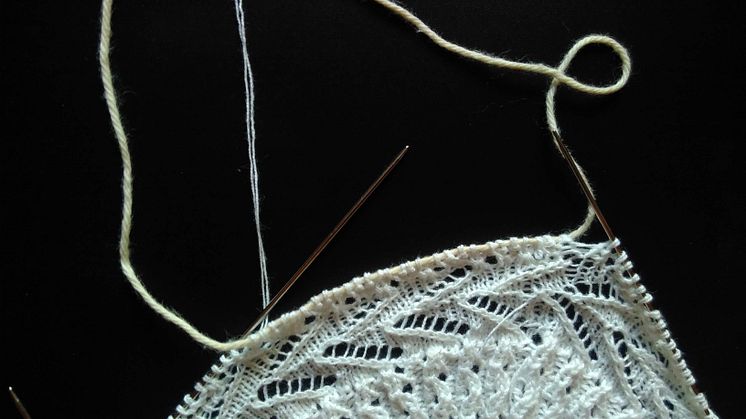Press release -
Finery for fashionable ladies
When the first descriptions of knitting and crochet were published in Swedish, in the mid-19th century, such handiwork was described as the finest of all feminine handicrafts, for the benefit and pleasure alike of the trend-conscious, diligent middle- and upper-class woman. Within a few decades, the patterns had moved into fashion journals. A new thesis from Uppsala University examines how these changes affected handicrafts.
These days, in the early 21st century, knitting and crocheting are in fashion. Making things by hand is more popular than ever. In social media groups, patterns are disseminated and images of handicraft projects shared, and ideas for solving problems discussed.” In bookshops, too, there are countless books and magazines containing patterns and instructions both for beginners and for the more experienced.
“All the same, there’s extremely little research on the role played by pattern models in how style trends, practical methods and perceptions of textile handiwork were established, disseminated and changed. The contribution of this thesis to the academic research field is that it begins to fill that knowledge gap,” says Hanna Bäckström, PhD student at the Department of Art History at Uppsala University.
In her thesis, Bäckström examines how publishing of knitting and crocheting patterns and instructions in books and magazines arose and developed during the first half and middle of the 19th century, when these handicrafts enjoyed a boom in popularity.
In the 1840s, the first knitting and crocheting manuals were published in Swedish, and patterns for these handicrafts also started featuring prominently in the fashion journals of the time. In these media, knitting and crochet were highlighted as beautiful and enjoyable pastimes for the trend-conscious and diligent middle- and upper-class woman. Analysis of attitudes to knitting and crochet expressed in the manuals’ prefaces shows that perceptions of them as feminine occupations grew stronger and were passed on, while the background of knitting as a male-dominated guild craft was ignored.
Mediation of printed patterns for knitting and crochet changed in the mid-19th century, for reasons that may be summarised in the following three factors:
- the scope and limitations of printing technology
- how the sales market for pattern models was organised
- publishers’ perceptions of the target group's handwork skills, habits and tastes.
To understand the design of the manuals and fashion journals published in Swedish, Hanna Bäckström compared them with those issued in other countries. Among those interested in the history of knitting and crochet, the emergence of a large market for patterns for these handicrafts in mid-19th century Britain is a well-known fact. On the other hand, the Swedish patterns turn out to have been largely translated from German publications. An extensive search for handicraft publications in bibliographies showed that publication of knitting and crochet patterns in the German-speaking area was also extensive, and began several decades before the genre was established in Britain.
The thesis covers how pattern design was characterised by innovations and traditions in the art of book printing, and by how the market was organised. Bäckström also studied how the specific terms and systems used in knitting and crocheting developed in the 19th century.
“In the first Swedish crochet manuals, varying and fairly complicated terms were used for chain stitches and trebles, such as ‘uppåt löpande dubbla kedjemaskor’ (rising double chain stitches). By the late 1840s, the terms ‘luftmaskor’ (chain stitches) and ‘stolpar’ (trebles) had become established,” says Hanna Bäckström.
In the course of her work, Bäckström had to work out a new method for handicraft research. By following the instructions herself, she sought to find out what skills and prior knowledge users required to understand the patterns.
“In trying to knit and crochet according to the patterns, I noticed how many printing errors they contain. These errors are hard to avoid, but there are so many of them, and they have a major bearing on whether the patterns can be used at all. They show that rapid publication was more important than quality control.”
Thesis: Bäckström H., The Mediation of Patterns for Knitting and Crochet: The Publications, the Market and the Target Group in Sweden in the mid-nineteenth century (in Swedish), Gidlunds förlag, http://urn.kb.se/resolve?urn=urn:nbn:se:uu:diva-434887
Further information about the research:
Hanna Bäckström, Department of Art History at Uppsala University, hanna.backstrom@konstvet.uu.se, mobile 46 733 71 07 65
Illustrations:
Two of the Swedish knitting books from the 1840s, “New Patterns for Lace Knitting, etc. and Lace Crocheting” (Nya Mönster till Spets-stickning m. m. samt Spets-Virkning, 1844) and “Charlotte Leander’s Knitting Book” (Charlotte Leanders Stickbok, 1848), contain instructions for knitting a child’s hat, translated from a German manual. The instructions contained so many printing errors that the products of the test knitting were of completely different shapes from those shown in the illustrations included in the manuals. (Left and middle of Figure 118)
Figures 120a and 120b show knitting of a child’s hat resembling the illustrations, by combining the two Swedish and two different versions of the German instructions.
Topics
Uppsala University
The first University in Sweden. Quality, knowledge, and creativity since 1477. Education and research of the highest quality and relevance to society, business, and culture. Uppsala University is ranked among the world’s top higher education institutions. www.uu.se




